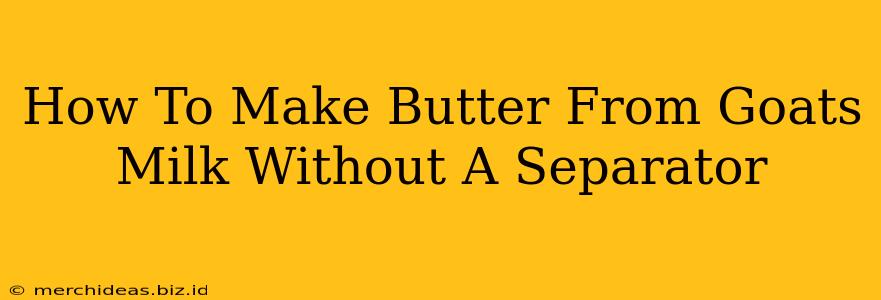Making butter from goat's milk is a rewarding experience, connecting you directly to the source of your food. While a separator makes the process easier, it's entirely possible to churn butter from goat's milk without one. This guide provides a step-by-step process, offering tips and tricks for success.
Understanding the Process
Before we dive into the specifics, let's understand the basic principles. Making butter involves separating the fat globules in milk (cream) and agitating them until they coalesce into butter. Since goat milk has a lower fat content than cow's milk, you'll need to increase the fat concentration before churning. This is achieved through a process called creaming.
Key Differences from Cow's Milk
Goat milk has a naturally lower fat content than cow's milk. This means you'll need to start with a larger volume of goat milk to yield a comparable amount of butter. Also, the resulting butter may have a slightly tangier or more distinctive flavor, reflecting the characteristics of goat's milk.
Making Butter from Goats Milk: A Step-by-Step Guide
1. Collecting and Storing the Milk: Begin with fresh, high-quality goat's milk. Allow it to settle undisturbed in the refrigerator for at least 12 hours, ideally 24. This allows the cream to rise naturally to the top. The longer you let it sit, the richer the cream will be.
2. Skimming the Cream: Carefully spoon or ladle the thick layer of cream from the top of the milk. Avoid disturbing the lower layers of milk. The more cream you collect, the more butter you’ll produce. You can save the remaining milk for drinking or other uses.
3. Cream Thickening (Optional but Recommended): For best results, especially if you have a relatively small amount of cream, consider thickening the cream. You can do this by gently simmering the cream in a saucepan over low heat until slightly thickened. Be careful not to boil it, or it will curdle. This step concentrates the fat, making butter production more efficient.
4. Churning the Cream: You have several options for churning:
-
Manual Churning: Use a wide-mouth jar, a glass bowl, or a dedicated butter churn (if you have one). Shake vigorously and continuously for at least 15-20 minutes, or longer, until the cream begins to separate into butter and buttermilk. The longer you churn, the firmer the butter will become. You'll know you're nearing completion when the mixture starts to sound "sloshy," and the butter forms into clumps.
-
Using a Mixer: A stand mixer or hand mixer works well, but you'll likely need to use a low speed to avoid splashing. Churn for a similar duration as manual churning, pausing occasionally to scrape down the sides of the bowl.
5. Separating the Butter: Once the butter has formed, separate it from the buttermilk. This can be done by pouring the mixture through a fine-mesh sieve lined with cheesecloth. The buttermilk will drain through, leaving the butter behind in the sieve.
6. Washing and Kneading the Butter: Rinse the butter under cold water, squeezing out excess buttermilk. This helps remove any lingering taste of buttermilk and improves the butter's texture. Once rinsed, knead the butter to remove any remaining water and to create a smooth, cohesive texture.
7. Storing Your Homemade Butter: Once you're satisfied with the consistency, shape the butter and store it in an airtight container in the refrigerator. It should keep for several weeks.
Tips for Success
- Patience is key: The churning process takes time and effort. Don't rush it.
- Start with a large quantity of milk: Goat's milk has less fat than cow's milk, so you'll need more to make a decent amount of butter.
- Experiment with different churning methods: Find the method that works best for you and your equipment.
- Use fresh milk: The fresher the milk, the better the butter will taste.
- Enjoy the process! Making butter from scratch is a rewarding experience.
Making butter from goat's milk without a separator is achievable with patience and the right technique. The process offers a deep connection to your food and a delicious reward. Enjoy your homemade goat milk butter!
